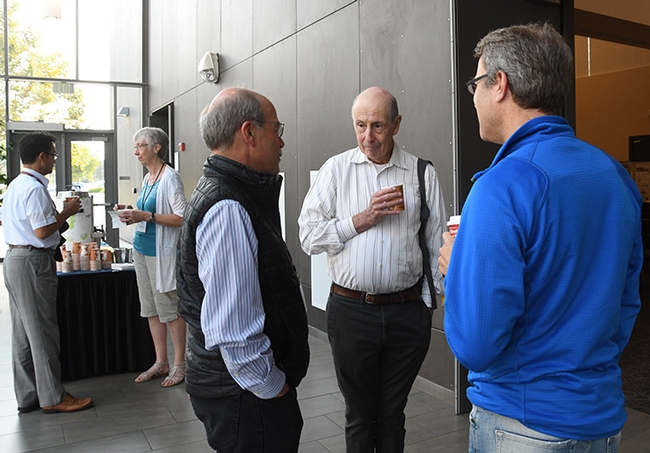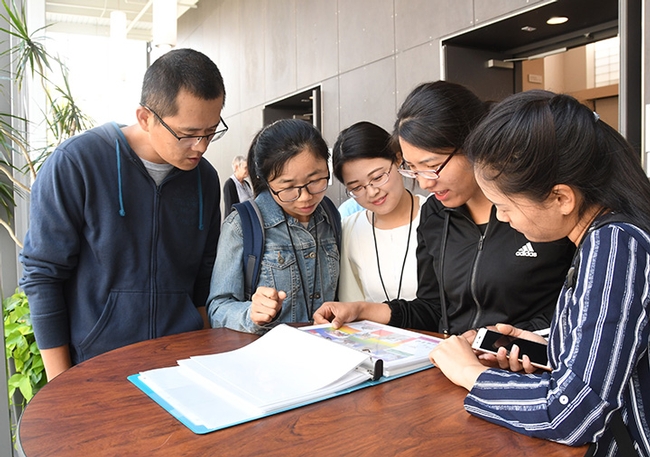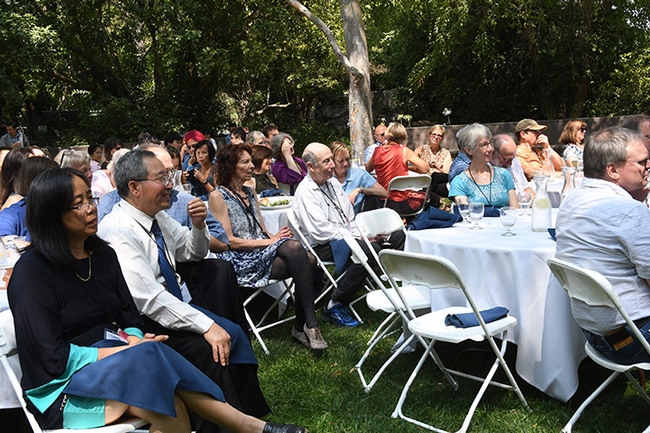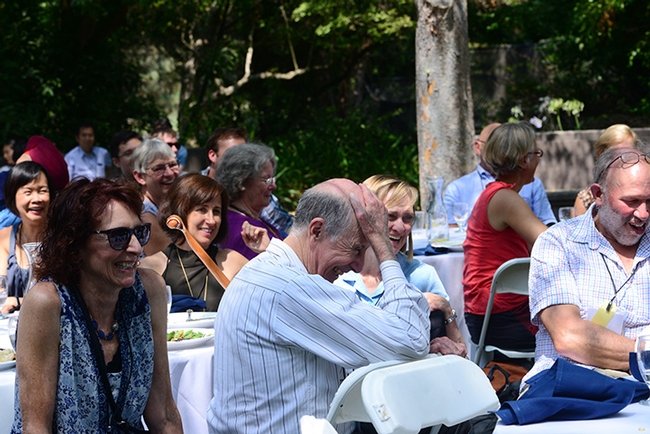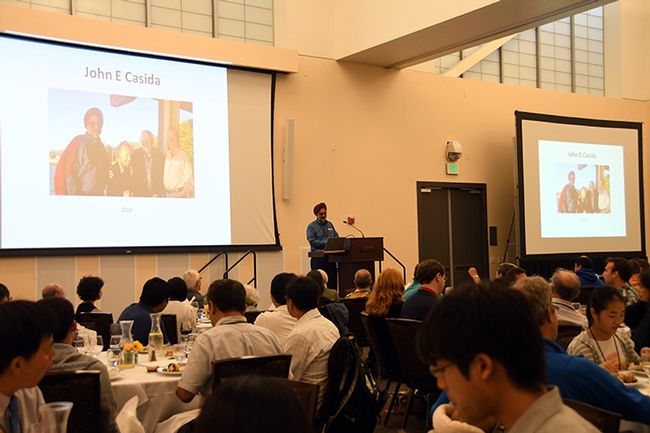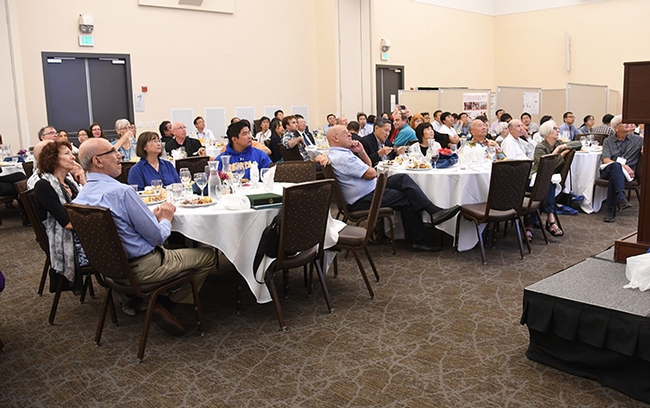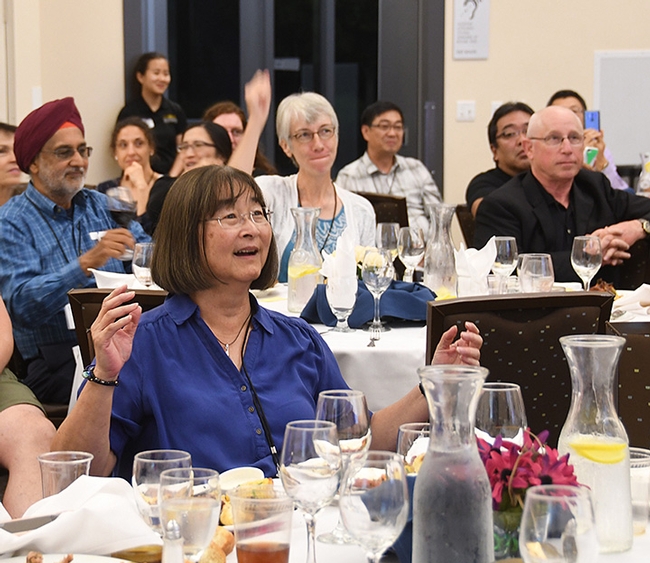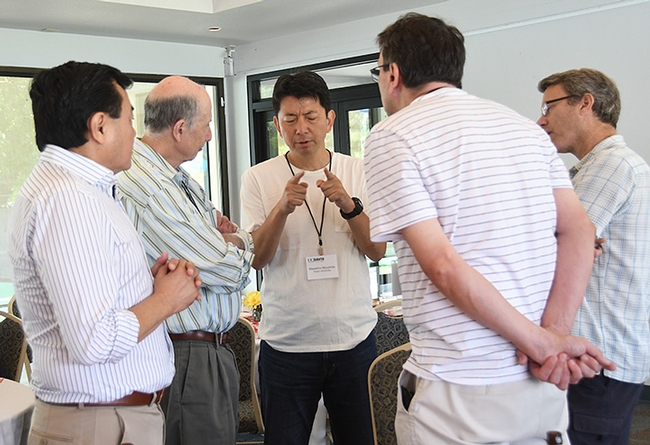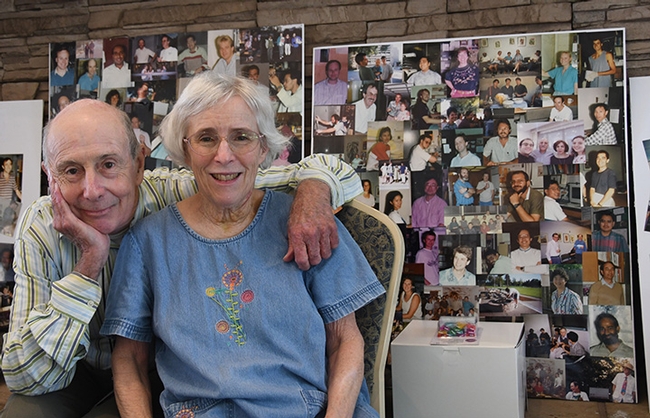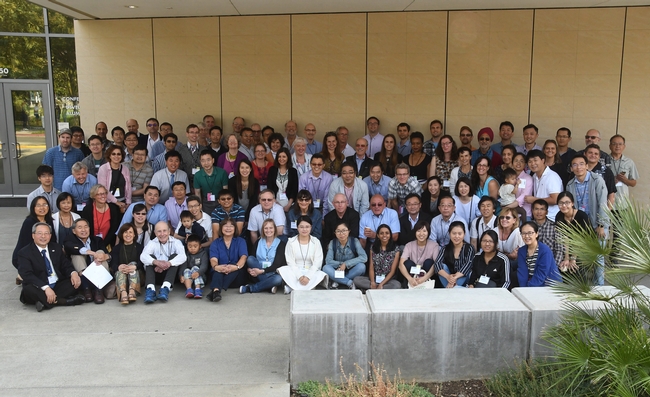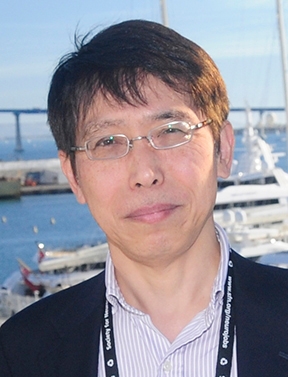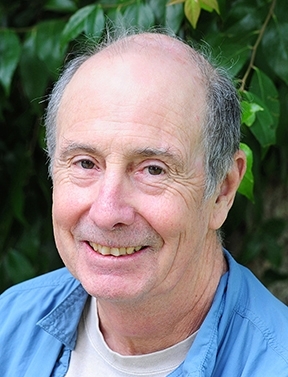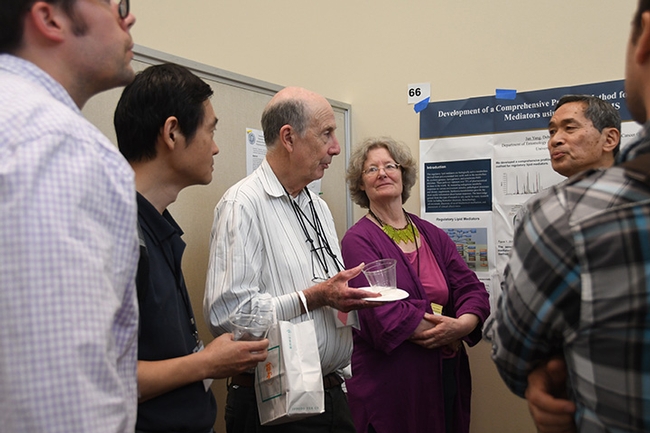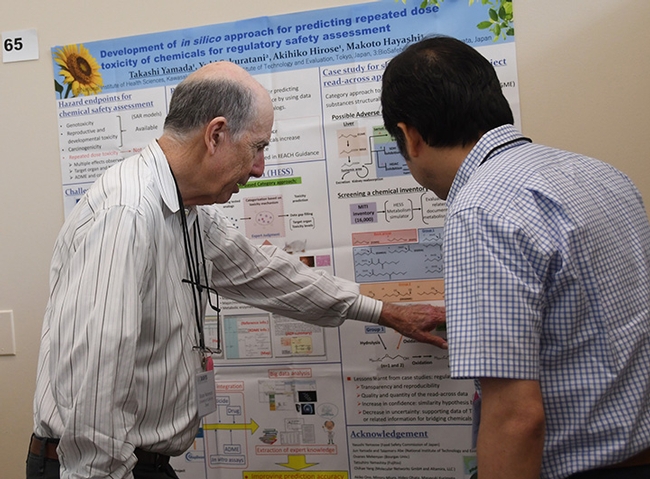- Author: Kathy Keatley Garvey
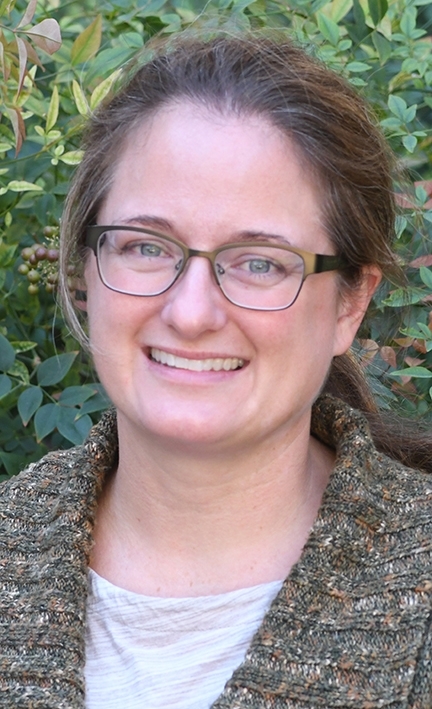
Every year some 10,000 burn victims in the United States undergo an acute inflammatory reaction and die of burn-related infections, according to the Centers for Disease Control and Prevention.
Now a newly published study by a research team from the laboratory of distinguished professor Bruce Hammock, University of California, Davis, and the Department of Surgery, University of Cincinnati College of Medicine (UC CoM), has identified a key regulatory mechanism in inflammation that may lead to new targets for resolving that inflammation—and the inflammation of patients with sepsis, cancer and COVID.
In research published in the current edition of Proceedings of the Natural Academy of Sciences, the scientists announced that they have discovered a pathway that regulates the immune response after infection or injury, such as burns. Dysregulation of this pathway could differentiate those who are at risk of fatal sepsis or help identify targets to resolve this unregulated inflammation.
“We are very excited about the findings in this paper and the far-reaching impacts it could have on understanding a key regulatory step in the immune response,” said co-lead author and researcher Cindy McReynolds of the Hammock lab and director of research at EicOsis, a Davis-based company founded by Hammock. Hammock, the corresponding author of the publication, has been involved in enzyme research for more than 50 years.
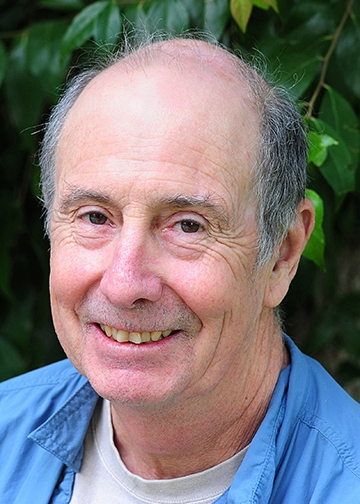
“Our previous work identified that these same lipid mediators were up-regulated in severe COVID infections, and we are now finding that these compounds play a role in modulating the immune response so that the body is unable to fight infection or respond properly to trauma without leading to a potentially fatal overreaction,” said McReynolds, who holds a doctorate in pharmacology and toxicology from UC Davis.

“The immunological disbalance we see in many cases of severe burn injury, trauma and sepsis pose a huge clinical challenge as we lack the understanding of how to diagnose and treat it,” said co-lead author Dr. Christian Bergmann, formerly with UC CoM's Department of Surgery and now headquartered in Germany with the University of Ulm's Department of Trauma Surgery, Hand, Plastic and Reconstructive Surgery. “With this work, we reveal an important mechanism how immune cells are functionally disabled by sEH-derived metabolites of linoleic acid.”
“The natural compounds we are studying in this paper are metabolites of linoleic acid (LA), an essential fatty acid the body needs in very small amounts to survive and is only available through the diet,” McReynolds explained. “At lower concentrations, these metabolites are necessary for regulating thermogenesis and heart health but promote inflammation at higher concentrations. LA is more stable and much cheaper than longer chain polyunsaturated fatty acids, so heavily processed foods have higher LA content to increase shelf-life. Additionally, agricultural practices, such as feeding animals corn-based diets, have increased LA in meats and dairy products.”

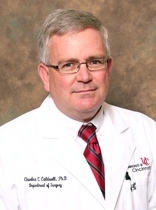
The research, titled "sEH-Derived Metabolites of Linoleic Acid Drive Pathologic Inflammation while Impairing Key Innate Immune Cell Function in Burn Injury,” is co-authored by Debin Wan, formerly of the Hammock lab and now a scientist at Escape Bio, San Francisco; Nalin Singh of the Hammock lab; and three UC CoM researchers: Charles Caldwell, professor and director, Division of Research, Department of Surgery; Dorothy Supp, adjunct professor in the Department of Surgery and a scientific staff member at Shriners Children's Ohio; and Holly Goetzman, principal research assistant in the Caldwell lab.
“Chronic pain is an enormous emotional and economic burden for more than 100 million people in the United States alone,” said co-author Hammock, who holds a joint appointment with the Department of Entomology and Nematology and the UC Davis Comprehensive Cancer Center. "The extreme and poorly treated pain that I observed as a medical officer working in a burn clinic in the Army, is a major driver for me to translate laboratory research to help patients with severe pain and at risk from sepsis." Another major influence: his mother served 15 years as a nurse in a children's hospital burn center, caring for hundreds of patients.
Hammock founded EicOsis in December 2011 to advance novel, safe and effective oral treatments for patients suffering from pain and inflammation. The LLC is developing a new class of oral non-narcotic analgesics based on inhibition of the soluble epoxide hydrolase enzyme. Human clinical trials are underway to test the drug candidate, EC5026, a first-in-class, small molecule that potently inhibits sEH. The sEH inhibitors have already shown to be effective for inflammatory and neuropathic pain in animals, with no apparent adverse or addictive reactions.
Several grants supported the research: Dr. Bergmann received a grant from Deutsche Forschungsgemeinschaft (German Research Foundation) and a National Institutes of Health (NIH) grant from the National Institute of General Medical Sciences (NIGMS); Supp, a grant from the Shriners Hospitals for Children; and Hammock, a RIVER (Revolutionizing Innovative Visionary, Environmental Health) grant from the NIH's National Institute of Environmental Health (NIEHS), and an NIH/NIEHS Superfund Program grant. Hammock has directed the UC Davis Superfund Program for nearly four decades.
Resources:
- PNAS paper
- UC Davis distinguished professor Bruce Hammock, bdhammock@ucdavis.edu

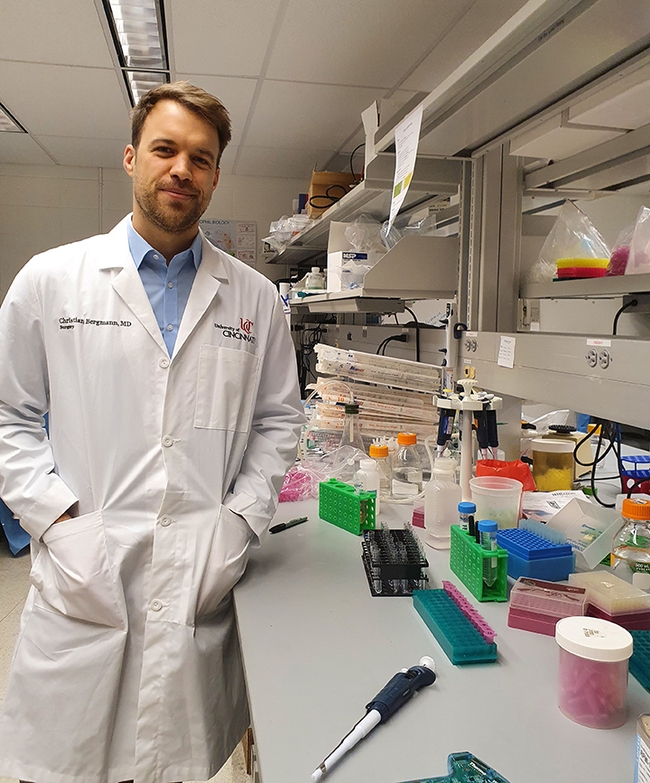
- Author: Kathy Keatley Garvey
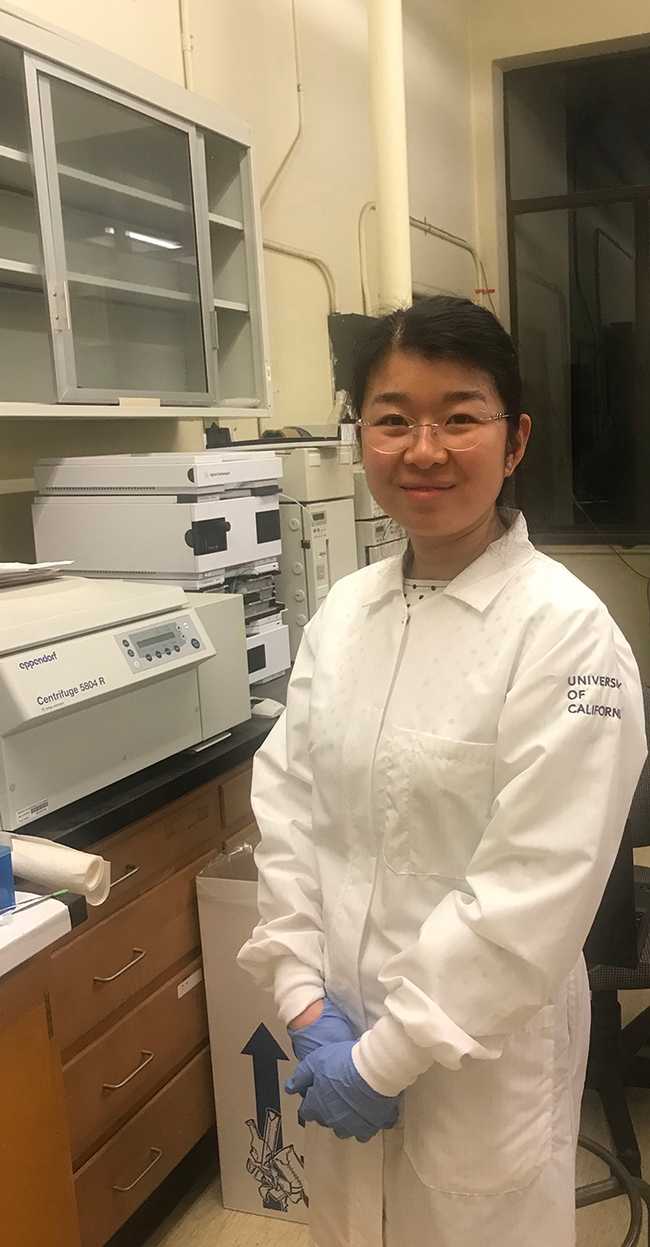
DAVIS--Newly published research in the Proceedings of the National Academy of Sciences (PNAS) indicates that a drug discovered and developed in the laboratory of Bruce Hammock,UC Davis Department of Entomology and Nematology, may have a major role in preventing and treating llnesses associated with obesity.
More than 43 percent of adults in the United States are obese, according to the Center for Disease Control and Prevention (CDC). Obesity increases the risk of coronary artery disease, stroke, type 2 diabetes, and certain kinds of cancer.
The drug, a soluble epoxide hydrolase (sEH) inhibitor, appears to regulate “obesity-induced intestinal barrier dysfunction and bacterial translocation,” the 12-member team of researchers from UC Davis, University of Massachusetts and University of Michigan discovered. The same non-opioid drug is being investigated in human clinical safety trials in Texas to see if it blocks chronic pain associated with diseases such as spinal cord injury, diabetes and inflammatory bowel disease.
The research, funded by multiple federal grants, is titled “Soluble Epoxide Hydrolase Is an Endogenous Regulator of Obesity-Induced Intestinal Barrier Dysfunction and Bacterial Translocation.”
“Obesity usually causes the loss of tight junctions and leaky gut,” said first author Yuxin Wang, a postdoctoral researcher who joined the Hammock lab in 2019 from the Department of Food Sciences, University of Massachusetts, Amherst. “In normal conditions, the gut mucosal barrier is like a defender to protect us from the ‘dirty things' in the lumen, such as bacteria and endotoxin. For obese individuals, the defender loses some function and leads to more ‘bad things' going into the circulation system, causing systemic or other organ disorders.”
Although intestinal dysfunction and other problems enhancing bacterial translocation underlies many human diseases, “the mechanisms remain largely unknown,” said Wang, who holds a doctorate in biochemistry and molecular biology from the Chinese Academy of Sciences. “What we found is sEH inhibition can repair the defender function (barrier function), decrease the ‘bad things' going into the blood (bacteria translocation), and reduce inflammation of fat.”
“Our research shows that sEH is a novel endogenous regulator of obesity-induced intestinal barrier dysfunction and bacterial translocation,” said corresponding author Guodong Zhang, a former researcher in the Hammock lab and now with the Food Science Department and Molecular and Cellular Biology Graduate Program at the University of Massachusetts. “To date, the underlying mechanisms for obesity-induced intestinal barrier dysfunction remain poorly understood. Therefore, our finding provides a novel conceptual approach to target barrier dysfunction and its resulting disorders with clinical/transitional importance.”
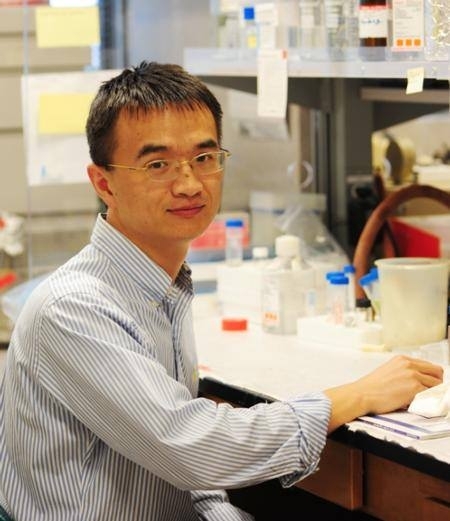
Corresponding author Hammock, a distinguished UC Davis professor who holds a joint appointment with the Department of Entomology and Nematology and the Comprehensive Cancer Center, praised Zhang's “amazing record while he was a postgraduate at UC Davis, and now in Food Science Department at the University of Massachusetts, where he recently received tenure.”
Zhang mentored two co-authors of the paper: Yuxin and Weicang Wang, both formerly of the Department of Food Science, University of Massachusetts and now with the Hammock lab.
“I feel so lucky that Yuxin and Weicang have joined my laboratory,” Hammock said. “The drugs studied in this PNAS paper are now in human clinical trials and on a path to replace opioid analgesics for pain treatment. I hope the continuing work of Guodong, Weicang and Yuxin will evaluate them as treatments for a variety of inflammatory bowel diseases.”
Andreas Baumler, professor and vice chair of research in the UC Davis Department of Medical Microbiology and Immunology, who was not affiliated with the study, said: “Obesity-induced gut leakage and bacterial translocation can be ameliorated by targeting microbes with antibiotics, suggesting that the microbiota contributes to disease. However, the work by Zhang and co-workers suggest that rather than targeting the microbes themselves, obesity-induced gut leakage and bacterial translocation can be normalized by silencing a host enzyme, which identifies host metabolism as an alternative therapeutic target.”
In addition to Hammock, Zhang, Yuxin and her husband Weicang, the other eight co-authors on the team are:
- Jun Yang, Sung Hee Hwang, and Debin Wan of the Hammock lab, UC Davis Department of Entomology and Nematology, and UC Davis Comprehensive Cancer Center
- Kin Sing Stephen Lee, formerly of the Hammock lab, and Maris Cinelli, both of the Department of Pharmacology and Toxicology, Michigan State University, Lansing
- Katherine Sanidad and Hang Xiao, Department of Food Science and the Molecular and Cellular Biology Graduate Program, University of Massachusetts, Amherst
- Daeyoung Kim, Department of Mathematics and Statistics, University of Massachusetts, Amherst
The abstract: “Intestinal barrier dysfunction, which leads to translocation of bacteria or toxic bacterial products from the gut into bloodstream and results in systemic inflammation, is a key pathogenic factor in many human diseases. However, the molecular mechanisms leading to intestinal barrier defects are not well understood, and there are currently no available therapeutic approaches to target intestinal barrier function. Here we show that soluble epoxide hydrolase (sEH) is an endogenous regulator of obesity-induced intestinal barrier dysfunction. We find that sEH is overexpressed in the colons of obese mice. In addition, pharmacologic inhibition or genetic ablation of sEH abolishes obesity-induced gut leakage, translocation of endotoxin lipopolysaccharide or bacteria, and bacterial invasion-induced adipose inflammation. Furthermore, systematic treatment with sEH-produced lipid metabolites, dihydroxyeicosatrienoic acids, induces bacterial translocation and colonic inflammation in mice. The actions of sEH are mediated by gut bacteria-dependent mechanisms, since inhibition or genetic ablation of sEH fails to attenuate obesity-induced gut leakage and adipose inflammation in mice lacking gut bacteria. Overall, these results support that sEH is a potential therapeutic target for obesity-induced intestinal barrier dysfunction, and that sEH inhibitors, which have been evaluated in human clinical trials targeting other human disorders, could be promising agents for prevention and/or treatment.”
The research was funded by grants from the National Institute of Food and Agriculture, U.S. Department of Food and Agriculture (USDA); National Cancer Institute; USDA Hatch Grant; National Institute of Environmental Health Sciences (NIEHS) Superfund Research Program; and a National Science Foundation.
According to the CDC, many of obesity-related conditions that lead to diseases are preventable. In 2008, the estimated annual medical cost of obesity in the United States tallied $147 billion. The medical cost for obese individuals averaged $1,429 higher than those of normal weight.
Contact: Bruce Hammock, bdhammock@ucdavis.edu
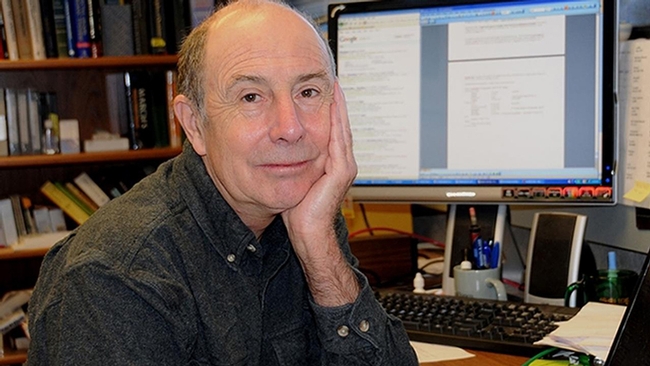
- Author: Kathy Keatley Garvey
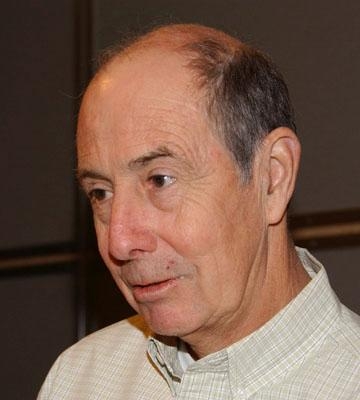
A Davis-based company founded by UC Davis distinguished professor Bruce Hammock has received the green light to begin Phase 1 clinical trials to test a non-narcotic drug candidate developed in the Hammock lab to alleviate chronic pain.
EicOsis LLC, a pharmaceutical startup, has received Investigational New Drug (IND) approval from the U.S. Food and Drug Administration to test the drug candidate, EC5026. Clinical trials are expected to begin this year.
"EicOsis is developing a new class of oral non-narcotic analgesics based on inhibition of the soluble epoxide hydrolase (sEH) enzyme," said EicOsis chief executive officer Hammock, who holds a joint appointment with the UC Davis Department of Entomology and Nematology and the UC Davis Comprehensive Cancer Center. UC Davis has licensed EC5026 exclusively to EicOsis.
EC5026 (BPN-19186) is described as a first-in-class, small molecule that potently inhibits soluble epoxide hydrolase (sEH). "It is key regulatory enzyme involved in the metabolism of membrane fatty acids," Hammock said. "Inhibition of sEH treats pain by stabilizing natural analgesic and anti-inflammatory mediators."
The sEH inhibitors developed by EicOsis have already shown to be effective for inflammatory and neuropathic pain in the rodents, horses, dogs and cats, with no apparent adverse or addictive reactions.
“Chronic pain management is a serious public health crisis with few options available that provide effective relief free of life-threatening safety concerns including abuse,” said UC Davis physician Scott Fishman, the Fullerton Endowed Chair in the Department of Anesthesiology and Pain Medicine, and professor and director of the Center for Advancing Pain Relief at the UC Davis School of Medicine. “The medical community is continually seeking effective pain management strategies. EicOsis's new compound is a novel pharmacological approach for treating pain, and I remain optimistic for its success.”
Approximately 50 million Americans (20 percent of the population) suffer from chronic pain, according to the Center for Disease Control and Prevention (CDC). The annual economic toll is $560 billion, encompassing direct medical expenses, lost productivity, and disability claims. Pain research is now one of the top priorities of the National Institutes of Health (NIH).
EicOsis advancement of EC5026 into clinical trials has been funded as part of the Blueprint Neurotherapeutics Network (BPN) of the NIH Blueprint for Neuroscience Research. The BPN is a collaboration of NIH Institutes and Centers that supports innovative research on the nervous system with the goal of developing new neurotherapeutic drugs.
“There is clear unmet need for new pain therapeutics," said BPN Program Director Charles L. Cywin. "sEH is an important pain target in our portfolio and we are excited to see EC5026 advance to human clinical development on the pathway to treating patients."
The development of EC5026 also drew financial support from the Helping to End Addiction Long-term, or the NIH HEAL Initiative via a grant to EicOsis, which is using the funds to de-risk the development process of EC5026 and to accelerate the start of clinical trials.
"It's clear that a multi-pronged scientific approach is needed to reduce the risks of opioids, accelerate development of effective non-opioid therapies for pain and provide more flexible and effective options for treating addiction to opioids,” said NIH Director Francis S. Collins, who launched the initiative in early 2018. “This unprecedented investment in the NIH HEAL Initiative demonstrates the commitment to reversing this devastating crisis.”
Contacts:
Media inquiries: info@eicosis.com
Investor inquiries: Cindy McReynolds at cbmcreynolds@eicosis.com
- Author: Kathy Keatley Garvey
An enzyme inhibitor developed in the UC Davis laboratory of Bruce Hammock and tested in mice by a team of international researchers shows promise that it could lead to a drug to prevent or reduce the disabilities associated with the neurodevelopmental disorders of autism and schizophrenia.
“We discovered that soluble epoxide hydrolase (sEH) plays a key role in inflammation associated with neurodevelopmental disorders. Inhibiting that enzyme stops the inflammation and the development of autism-like and schizophrenia-like symptoms in animal models,” said collaborator Kenji Hashimoto, a professor with the Chiba University Center for Forensic Mental Health, Japan. The scientists found higher levels of sEH in a key region of the brain—the prefrontal cortex of juvenile offspring-- after maternal immune activation (MIA).
“Mothers who have MIA, which results from severe stress in that region of the brain, have an increased occurrence of neurodevelopment disorders in their offspring,” Hashimoto explained. “In our study, the sEH enzyme increased dramatically in a key brain region of mice pups from mothers with MIA.”
The research, published today (March 18) in the Proceedings of the National Academy of Sciences (PNAS), is the work of 14 researchers from Chiba University Center for Forensic Mental Health; the Laboratory for Molecular Psychiatry, RIKEN Center for Brain Science, in Wako, Saitama, Japan; and the Hammock laboratory.
Research in Mice Pups
By inhibiting sEH, the researchers reversed cognitive and social interaction deficiencies in the mice pups. They hypothesize that this is due to increasing natural chemicals, which prevent brain inflammation. In people, this could reduce the disabilities associated with autism, such as anxiety, gastrointestinal disturbances and epilepsy.
“The same chemical and biochemical markers behaved as predicted in human stem cells,” said Hammock, a distinguished professor who holds a joint appointment with the Department of Entomology and Nematology and the UC Davis Comprehensive Cancer Center.
Earlier studies have indicated a genetic disposition to the disorders. The team also studied postmortem brain samples from autism patients that confirmed the alterations.
“In the case of both autism and schizophrenia, the epidemiology suggests that both genetics and environment are contributing factors,” said neuroscientist and associate professor Amy Ramsey of the Department of Pharmacology and Toxicology, University of Toronto, who was not involved in the study. “In both cases, maternal infection is a risk factor that might tip the scales for a fetus with a genetic vulnerability. This study is important because it shows that their drug can effectively prevent some of the negative outcomes that occur with prenatal infections. While there are many studies that must be done to ensure its safe use in pregnant women, it could mitigate the neurological impacts of infection during pregnancy.”
Neuroscientist Lawrence David, professor and chair of the School of Public Health, University of Albany, N.Y., who was not involved in the research, said that the study might lead to “an important therapeutic intervention for neurodevelopment disorders.”
Might Be Important Therapeutic Invervention
“There is increasing evidence that maternal immune activation activities (MIA) during fetal development can lead to aberrant neurobehaviors, including autistic-like activities,” said Lawrence, who studies neuroimmunology and immunotoxicology. The study “suggests that enzymatic control of fatty acid metabolism is implicated in neuroinflammation associated with schizophrenia and autism spectrum disorders. The expression of Ephx2 giving rise to soluble epoxide hydrolase (sEH) influences production of fatty acid metabolites, which elevate inflammation in the experimental model of mice after MIA; the sEH inhibitor TPPU (N-[1-(1-oxopropyl)-4-piperidinyl]-N'-[4-(trifluoromethoxy)phenyl)-urea) was postnatally used to improved behaviors. Analysis of cadaver brains from individuals with ASD also expressed increased sEH. Fatty acid metabolites have been known to affect fetal development, especially that of the brain; therefore, TPPU might be an important therapeutic intervention for neurodevelopmental disorders.”
Molecular bioscientist Isaac Pessah of the UC Davis School of Veterinary Medicine, distinguished professor and associate dean of research and graduate education in the Department of Molecular Biosciences, described the findings as “significant” and called for more detailed and expanded studies.
“There is mounting evidence that inappropriate maternal immune responses during pregnancy to infection contributes elevated risk to autism spectrum disorder, at least in a fraction of cases,” Pessah said. “The most significant findings reported here is that a commonly used mouse model of immune-triggered behavioral deficits mimicking some of the core symptoms in autistic children can be suppressed by inhibiting a novel biochemical target, soluble epoxide hydrolase; a target not previously explored as a target for therapeutic intervention to treat ASDs. These findings provide a rational basis for more detailed and expanded studies in mice carrying mutations implicated in ASDs to determine whether the therapeutic benefits of soluble epoxide hydrolase inhibitor(s) observed in this study are more generalizable.”
Autism in the United States
The Center for Disease Control and Prevention (CDC) estimates that 1 in 68 children in the United States have autism, commonly diagnosed around age 3. It is four times more common in boys than girls. CDC defines autism spectrum disorder as a “developmental disability that can cause significant social, communication and behavioral challenges.” The disorder impairs the ability to communicate and interact.
Approximately 3.5 million people or 1.2 percent of the population in the United States are diagnosed with schizophrenia, one of the leading causes of disability, according to the Schizophrenia and Related Disorders Alliance of America (SARDAA). Scores more go unreported. Approximately three-quarters of persons with schizophrenia develop the illness between 16 and 25 years of age. Statistics also show that between one-third and one half of all homeless adults have schizophrenia, and 50 percent of people diagnosed have received no treatment. Among the symptoms: delusions, hallucinations, disorganized speech, disorganized or catatonic behavior, and obsessive-compulsive disorders, such as hoarding, according to SARDAA.
Promising Prophylactic or Theraputic Target
In their research paper, titled “Key Role of Soluble Epoxide Hydrolase in the Neurodevelopmental Disorders of Offspring After Maternal Immune Activation,” the scientists described sEH as “a promising prophylactic or therapeutic target for neurodevelopmental disorders in offspring after MIA.”
First author Min Ma and second Qian Ren of the Hashimoto lab conducted the animal and biochemical work, while chemists Jun Yang and Sung Hee Hwang of the Hammock lab performed the chemistry and analytical chemistry. Takeo Yoshikawa, a team leader with the RIKEN's Molecular Psychiatry Laboratory, performed measurements of gene expression in the neurospheres from iPSC (induced pluripotent stem cells) from schizophrenia patients and postmortem brain samples from autism patients.
Hashimoto described the international collaboration as “exciting and productive.” This is their third PNAS paper in a series leading to endoplasmic reticulum stress. “We report discovery of a biochemical axis that leads to multiple neurological disorders, including depression, Parkinson's disease, schizophrenia, autism spectrum disorders and similar diseases,” he said.
First Human Trials
William Schmidt, vice president of clinical development at EicOsis, a Davis-based company developing inhibitors to sEH to treat unmet medical needs in humans and companion animals, said the company is developing a first-in-class therapy for neuropathic and inflammatory pain. “EicOsis is in the process of finalizing our first human trials on the inhibitors of the soluble epoxide hydrolase, originally reported from UC Davis,” Schmidt said. “We are targeting the compounds as opioid replacements to treat peripheral neuropathic pain. It is exciting that the same compound series may be used to prevent or treat diseases of the central nervous system.”
Several grants from the National Institutes of Health, awarded to Hammock, supported the research. Hammock praised the many collaborators and students he has worked with on the project. “This work illustrates the value of research universities in bringing together the diverse talent needed to address complex problems,” Hammock said. “It also illustrates the value of fundamental science. This autism research can be traced directly to the fundamental question of how caterpillars turn into butterflies.”
Now working solely on research to benefit humankind, Hammock began his career in insect science at UC Berkeley where he investigated how epoxide hydrolase degrades a caterpillar's juvenile hormone. The process leads to metamorphosis from the larval stage to the adult insect. Hammock then wondered "Does the enzyme occur in plants? Does it occur in mammals?"
It does, and particularly as a soluble epoxide hydrolase in mammals.
"Science is full of surprises," said Hammock, who founded EicOsis to help human patients conquer pain without opioids. "We need to remember that the concept, the clinical target, and even the chemical structure, came from asking how caterpillars turn into butterflies."
____________________________________________________________________________________________
ABSTRACT, PNAS Paper, "Key Role of Soluble Epoxide Hydrolase in the Neurodevelopmental Disorders of Offspring After Maternal Immune Activation"
“Maternal infection during pregnancy increases the risk of neurodevelopmental disorders such as schizophrenia and autism spectrum disorder (ASD) in offspring. In rodents, maternal immune activation (MIA) yields offspring with schizophrenia- and ASD-like behavioral abnormalities. Soluble epoxide hydrolase (sEH) plays a key role in inflammation associated with neurodevelopmental disorders. Here we found higher levels of sEH in the prefrontal cortex (PFC) of juvenile offspring after MIA. Oxylipin analysis showed decreased levels of epoxy-fatty acids in the PFC of juvenile offspring after MIA, supporting increased activity of sEH in the PFC of juvenile offspring. Furthermore, the expression of sEH (or EPHX2) mRNA in iPSC-derived neurospheres from schizophrenia patients with the 22q11.2 deletion was higher than that of healthy controls. Moreover, the expression of EPHX2 mRNA in the postmortem brain samples (Brodmann area 9 and 40) from ASD patients was higher than that of controls. Treatment of TPPU (a potent sEH inhibitor) into juvenile offspring from P28 to P56 could prevent cognitive deficits and loss of parvalbumin (PV)-immunoreactivity in the medial PFC of adult offspring after MIA. In addition, dosing of TPPU to pregnant mothers from E5 to P21 could prevent cognitive deficits, and social interaction deficits and PV-immunoreactivity in the mPFC of juvenile offspring after MIA. These findings suggest that increased activity of sEH in the PFC plays a key role in the etiology of neurodevelopmental disorders in offspring after MIA. Therefore, sEH would represent a promising prophylactic or therapeutic target for neurodevelopmental disorders in offspring after MIA.”
Related Research Published in PNAS
- Soluble Epoxide Hydrolase Plays a Key Role in the Pathogenesis of Parkinson's Disease
- Gene Deficiency and Pharmacological Inhibition of Soluble Epoxide Hydrolase Confers Resilience to Repeated Social Defeat Stress
Contacts:
Bruce Hammock, bdhammock@ucdavis.edu
Kenji Hashimoto, hashimoto@faculty.chiba-u.jp
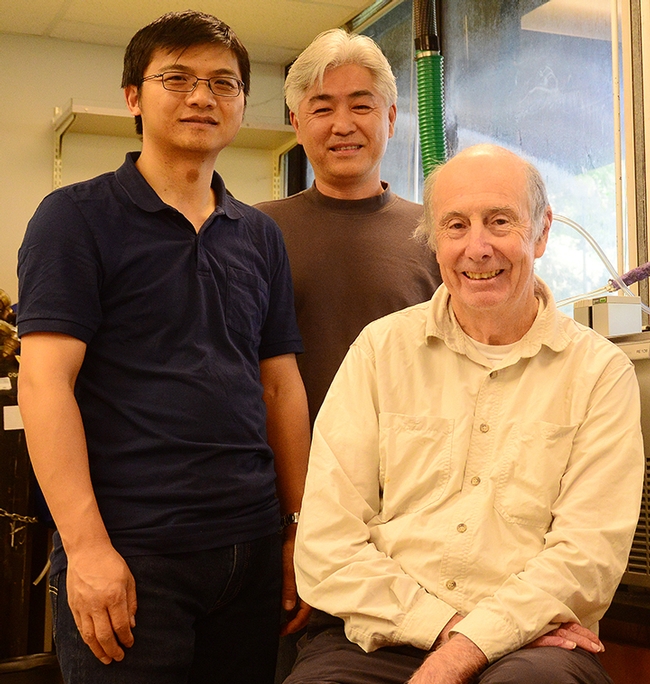
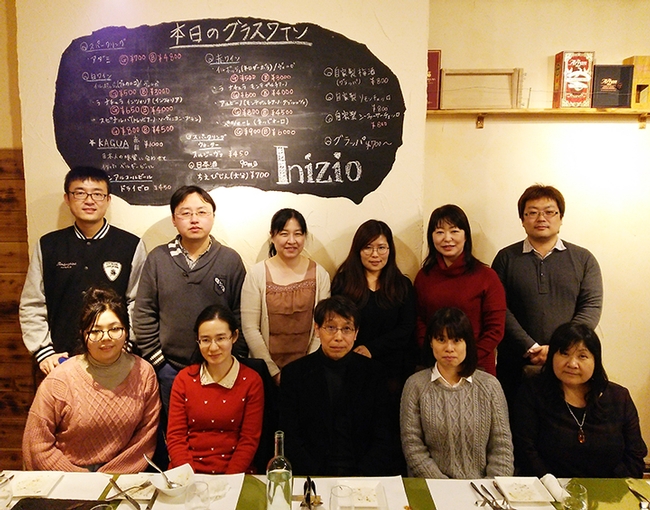
- Author: Kathy Keatley Garvey
Should auld acquaintance be forgot,
and never brought to mind?
No, they won't—at least not for Bruce Hammock, a distinguished professor at the University of California, Davis, and the hundreds of scientists he's trained over an academic career spanning more than four decades at UC Davis and UC Riverside.
Looking back over 2018, Hammock remembers fondly the weekend that 100 of his former laboratory alumni from 10 countries traveled to Davis to honor his work, reunite, collaborate, and reminiscence.
Billed as “Biochemistry and Society: Celebrating the Career of Professor Bruce Hammock,” the three-day event drew Hammock lab alumni from throughout the United States, as well as Egypt, Spain, China, Australia, New Zealand, Germany, Sweden, Canada and the Czech Republic.
“It was really special and I will treasure that weekend always,” said Hammock, who trained scientists at UC Riverside for five years before joining the UC Davis faculty in 1980. He currently holds a joint appointment with the UC Davis Department of Entomology and Nematology and the UC Davis Comprehensive Cancer Center. He has directed the UC Davis Superfund Program, funded by the National Institutes of Health's National Institute of Environmental Health (NIH/NIEHS), for 31 years.
The distinguished professor, known for his expertise in chemistry, toxicology, biochemistry and entomology, meshes all four sciences in his 50-year research on acute and neuropathic pain in humans and companion animals. It all began with his basic research on how caterpillars become butterflies, research that led to key discoveries about chronic pain.
Since then, his lab has generated more than 80 patents, 300 postdoctoral fellows, and more than 65 graduates, who now hold positions of distinction in academia, industry and government.
Hammock's colleagues, and former postdoctoral fellows, graduate and undergraduate students and visiting scholars arrived at the lab reunion with their spouses--as well as their scientific posters for display and discussion. The posters covered everything from ground-breaking research in prestigious journals to a humorous look at his annual water balloon battles in front of Briggs Hall.
The scientists dined at the UC Davis Conference Center, the Buehler Alumni Center and the Stonegate Country Club; shared months, years and decades of memories; and toasted, roasted and gifted their mentor. Hammock, in turn, toasted, roasted and gifted them.
“We had a blast,” recalled organizer Shirley Gee, a former research toxicologist and manager of the Hammock lab for 31 years. She retired in June 2016 after 40 years of service with the university.
“I have had a vision of this event to honor Bruce for many years now, and it was such a thrill to see it come together,” she said. “Reconnecting in person with all the alumni and their families was more rewarding than I could have imagined, but even more importantly was the thrill of watching alumni reconnect with each other! There were a lot of tears in the house. Many people I think were surprised by how the years melted away when they began reacquainting. I think that speaks to the environment that Bruce created that led to many strong personal and professional bonds.”
Gee credited her seven-member committee—former Hammock students Keith Wing, Jim Ottea, Tom Sparks, Babak Borhan, Qing Li; postdoctoral fellow and “academic grandson” Kin Sing Stephen Lee, a former student of Babak Borhan; and colleague Sarjeet Gill, now a distinguished professor at UC Riverside, with greatly contributing to the success of the one-of-a-kind celebration.
As graduate students, and Hammock and Gill worked together in the John Casida lab at UC Berkeley and later in Larry Gilbert's lab where they co-discovered the enzyme, soluble epoxide hydrolase. Hammock remembers researching juvenile hormones and what's involved in "how caterpillars became butterflies."
Hammock has studied the enzyme system and its inhibitors ever since. He recently formed a Davis-based company, EicOsis, to develop an orally active non-addictive drug for inflammatory and neuropathic pain for human beings and companion animals. Human clinical trials are scheduled to begin in 2019. Several seed-fund grants and a NIH/NINDS (National Institute of Neurological Disorders and Stroke) Blueprint Development Grant support EicOsis.
Hammock, described at the lab reunion as a “genius,” collaborates with scientists worldwide in what's been described as “unprecedented research with a multidisciplinary, integrated approach to research focused on insect biology, mammalian enzymology, and analytical chemistry.” He has authored more than 1000 publications on a wide range of topics in entomology, biochemistry, analytical and environmental chemistry in high quality journals, and has been cited more than 54,000 times. In the epoxide hydrolase field, the Hammock laboratory has published almost 900 peer-reviewed papers.
Tom Sparks, who was Hammock's first graduate student at UC Riverside, chronicled Hammock's career and recalled humorous anecdotes from his early professorship at UC Riverside. A former professor at Louisiana State University, and now a research fellow in Discovery Research at Dow AgroSciences (now Corteva Agriscience, Indianapolis, Sparks praised Hammock's intellect and curiosity. “For Bruce, it was all about the journey, looking around and operative at the interface between entomology, biochemistry and chemistry.”
Gill, along with University of Utah emeritus professor Glenn Prestwich and UC Davis research scientist Karen Wagner also delivered presentations, fondly recalling their shared time and science with Hammock.
Keith Wing, who was Hammock's second graduate student at UC Riverside/Davis, served as emcee at the lab reunion. A former senior research associate at DuPont and Rohm and Haas and current consultant, Wing said “Bruce has inspired many hundreds of developing scientists. For myself and many others, he was able to see what we could become as scientists and social contributors before we could see it ourselves."
Qing Li, a professor in the University of Hawaii's Department of Molecular Biosciences and Bioengineering College of Tropical Agriculture and Human Resources who received his doctorate from UC Davis, studying with major professors Bruce Hammock and James Seiber, said that "Bruce is an eminent scientist and a great mentor. Many of us have benefited from his effective mentorship. Back in 1990, after he signed my dissertation, he shook my hand, and then he asked me to tape-record it and give him the recordings -- a great 'homework' assignment and good practices for me."
Others commented that they learned this from Hammock: “We explore the unexpected and get to do things that don't work” and “Design things to fail; when they don't fail follow along.”
Hammock, the crowd agreed, seems to follow baseball legend Yogi Berra's sage advice: “If you come to a fork in the road, take it.”
Gill praised Hammock's “impact on human health, environmental health” as well as his love of the outdoors—from kayaking to mountain climbing.
Numerous alumni lauded Hammock's sense of humor. One scientist quoted Albert Einstein as saying “Creativity is intelligence having fun” and added “Bruce is always having fun.”
Among the other comments:
- “I never heard him speak a cross word.”
- "He treats everyone with respect.”
- "Bruce loves science and he loves people.”
- "He never heard a crazy idea.”
- "What Bruce does—he delivers the future.”
- "Bruce has a lot of determination and can approach difficult problems from multiple angles.”
- "Bruce values strong relationships with friends he has made over the years”
A native of Little Rock, Ark., Hammock received his bachelor of science degree, magna cum laude, in 1969 from Louisiana State University, Baton Rouge, where he majored in entomology and minored in zoology and chemistry. Then it was off to UC Berkeley, for his doctorate in entomology/toxicology in 1973, and postdoctoral fellowship.
It was at UC Berkeley where he met and married his wife, Lassie, who had just entered the doctoral program in plant physiology. They married in 1972 and then “the Army called me up,” Hammock remembers.
Hammock served as a public health medical officer/first lieutenant with the U.S. Army Academy of Health Science in San Antonio, Texas; and then did more postdoctoral research at the Rockefeller Foundation, Department of Biology, Northwestern University, Evanston. Ill.
Hammock then joined the faculty of the Division of Toxicology and Physiology, UC Riverside Department of Entomology in 1975 before heading for UC Davis in 1980 to accept a joint-faculty appointment in toxicology and entomology.
Bruce and Lassie reared three children: Tom, Bruce and Frances. “Frances and her husband, Adrian, teach math at UC San Diego; Bruce is on the UC Davis School of Veterinary Medicine faculty; and Tom, a graduate of the American Film Institute Conservatory, makes movies,” Hammock said, adding that he and Lassie appeared in one of the movies that Tom directed: "The Last Survivors."
Highly honored by his peers, Hammock is a fellow of the National Academy of Inventors, which honors academic invention and encourages translations of inventions to benefit society. He is a member of the U.S. National Academy of Sciences, a fellow of the Entomological Society of America, and the recipient of scores of awards, including the Bernard B. Brodie Award in Drug Metabolism, sponsored by the America Society for Pharmacology and Experimental Therapeutics; and the first McGiff Memorial Awardee in Lipid Biochemistry.
Hammock told the crowd at the reunion that he began his career studying insect science but switched to human research after encountering “all the suffering involved in acute and neuropathic pain.”
His insect science research centered around how a key enzyme, epoxide hydrolase, degrades a caterpillar's juvenile hormone, leading to metamorphosis from the larval stage to the adult insect. He then wondered "Does the enzyme occur in plants? Does it occur in mammals?" It does, and particularly as a soluble epoxide hydrolase in mammals.
“It is always important to realize that the most significant translational science we do in the university is fundamental science,” said Hammock. “The extreme and poorly treated pain that I observed as a medical officer in a burn clinic in the Army, is a major driver for me to translate this knowledge to help patients with severe pain.”
And it all began with him asking how caterpillars turn into butterflies.
"Science is full of surprises," the distinguished UC Davis professor said. "We need to remember that the concept, the clinical target, and even the chemical structure came from asking how caterpillars turn into butterflies."
